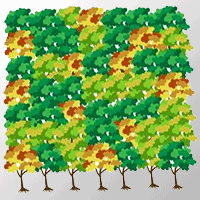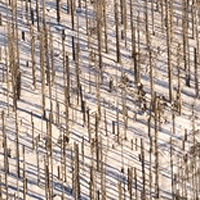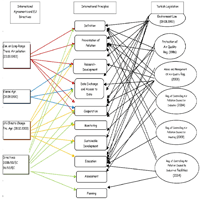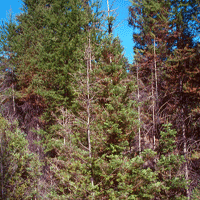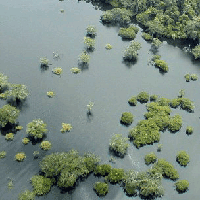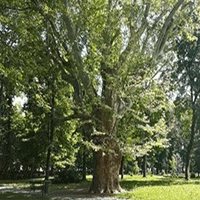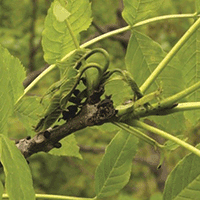
SilvaCuore: a web-application to monitor the health status of Italian forests
Maria Castellaneta (1) , Michele Colangelo (1), Giacomo Colle (2), Angelo Rita (3), Francesco Ripullone (1)
iForest - Biogeosciences and Forestry, Volume 17, Issue 5, Pages 317-322 (2024)
doi: https://doi.org/10.3832/ifor4562-017
Published: Sep 30, 2024 - Copyright © 2024 SISEF
Review Papers
Collection/Special Issue: Project LIFE MODERn(NEC)
Workshop "Climate change and forest health monitoring in Italy" - Rome (Italy) May 5, 2023
Guest Editors: Bussotti F, Pollastrini M
Abstract
In the current context of climate change, this paper provides a brief overview of climate-vegetation interactions in the Mediterranean basin, where global warming and aridification trends are predicted to intensify. Rising temperatures coupled with extreme drought events have notable impacts on forest ecosystems, triggering dieback and mortality phenomena worldwide. The health status of forest vegetation may be assessed by either ground surveys or remote sensing. Several investigations of declining oak forests in the Apennine region have shown that the drought vulnerability of Mediterranean oaks is dependent on differences in access to deep soil water pools, which can be related to differences in rooting depth, tree size and growth rate. Forest dieback is widely reported in Italy, but the extent and overall distribution of this phenomenon have not yet been well defined. Thus, understanding the future dynamics of forest stands has several key objectives: inventorying declining forest stands to gain insight into the phenomenon and create a national-level database; locating these stands to allow monitoring of their evolution over time; and monitoring to allow planning of mitigation measures, as well as recovery and adaptation strategies. This background led to the implementation of SilvaCuore, the first web application designed in Italy to report forest health status. Silvacuore is a web application developed with the aim of improving the link between citizens and the scientific community by contributing to the development of a valuable scientific database. The direct involvement of citizens in forest preservation offers an interesting perspective because the innovative use of technology can tap into citizens’ growing enthusiasm for environmental topics. Thus, SilvaCuore may be viewed from a dual perspective as a resource for the scientific community and as a unique opportunity for citizens to take an active role in research activities (Citizen Science project).
Keywords
Climate Change, Citizen Science, Drought, Forest Dieback, Mediterranean Environment
Authors’ Info
Authors’ address
Michele Colangelo 0000-0002-6687-3125
Francesco Ripullone 0000-0003-4851-3422
Dipartimento di Scienze Agrarie, Forestali, Alimentari e dell’Ambiente, Università della Basilicata, Potenza (Italy)
Consiglio per la ricerca in agricoltura e l’analisi dell’economia agraria, Via della Navicella 2/4, Roma (Italy)
Dipartimento di Agraria, Università di Napoli Federico II, via Università 100, 80055 Portici, NA (Italy)
Corresponding author
Paper Info
Citation
Castellaneta M, Colangelo M, Colle G, Rita A, Ripullone F (2024). SilvaCuore: a web-application to monitor the health status of Italian forests. iForest 17: 317-322. - doi: 10.3832/ifor4562-017
Academic Editor
Martina Pollastrini
Paper history
Received: Jan 16, 2024
Accepted: Jul 26, 2024
First online: Sep 30, 2024
Publication Date: Oct 31, 2024
Publication Time: 2.20 months
Copyright Information
© SISEF - The Italian Society of Silviculture and Forest Ecology 2024
Open Access
This article is distributed under the terms of the Creative Commons Attribution-Non Commercial 4.0 International (https://creativecommons.org/licenses/by-nc/4.0/), which permits unrestricted use, distribution, and reproduction in any medium, provided you give appropriate credit to the original author(s) and the source, provide a link to the Creative Commons license, and indicate if changes were made.
Web Metrics
Breakdown by View Type
Article Usage
Total Article Views: 6819
(from publication date up to now)
Breakdown by View Type
HTML Page Views: 4155
Abstract Page Views: 1287
PDF Downloads: 1121
Citation/Reference Downloads: 0
XML Downloads: 256
Web Metrics
Days since publication: 438
Overall contacts: 6819
Avg. contacts per week: 108.98
Citation Metrics
Article Citations
Article citations are based on data periodically collected from the Clarivate Web of Science web site
(last update: Mar 2025)
(No citations were found up to date. Please come back later)
Publication Metrics
by Dimensions ©
Articles citing this article
List of the papers citing this article based on CrossRef Cited-by.
References
A global overview of drought and heat-induced tree mortality reveals emerging climate change risks for forests. Forest Ecology and Management 259: 660-684.
CrossRef | Gscholar
Aboveground woody carbon sequestration measured from tree rings is coherent with net ecosystem productivity at five eddy-covariance sites. New Phytologist 201: 1289-1303.
CrossRef | Gscholar
Forest and woodland replacement patterns following drought-related mortality. Proceedings of the National Academy of Sciences USA 117 (47): 29720-29729.
CrossRef | Gscholar
Long-term temporal relationships between environmental conditions and xylem functional traits: a meta-analysis across a range of woody species along climatic and nitrogen deposition gradients. Tree Physiology 37 (1): 4-17.
CrossRef | Gscholar
Forest resilience to drought varies across biomes. Global Change Biology 24 (5): 2143-2158.
CrossRef | Gscholar
Drought-induced oak decline in the western Mediterranean region: an overview on current evidences, mechanisms and management options to improve forest resilience. iForest - Biogeosciences and Forestry 10 (5): 796-806.
CrossRef | Gscholar
Research frontiers for improving our understanding of drought-induced tree and forest mortality. New Phytologist 218 (1): 15-28.
CrossRef | Gscholar
Climate change 2014: impacts, adaptation, and vulnerability. Part A: Global and sectoral aspects. In: “Contribution of Working Group II to the Fifth Assessment Report of the Intergovernmental Panel on Climate Change” (Field CB, Barros VR, Dokken DJ, Mach KJ, Mastrandrea MD, Bilir TE, Chatterjee M, Ebi KL, Genova RC, Girma B, Kissel ES, Levy AN, MacCracken S, Mastrandrea PR, White LL, Estrada YO eds). Cambridge University Press, Cambridge, UK and New York, NY, USA, pp. 1132.
Gscholar
Global satellite monitoring of climate-induced vegetation disturbances. Trends in Plant Science 20: 114-123.
CrossRef | Gscholar
The Interplay of the tree and stand-level processes mediate drought-induced forest dieback: evidence from complementary remote sensing and tree-ring approaches. Ecosystems 25: 1738-1753.
CrossRef | Gscholar
Diverse relationships between forest growth and the Normalized Difference Vegetation Index at a global scale. Remote Sensing of Environment 187: 14-29.
CrossRef | Gscholar

